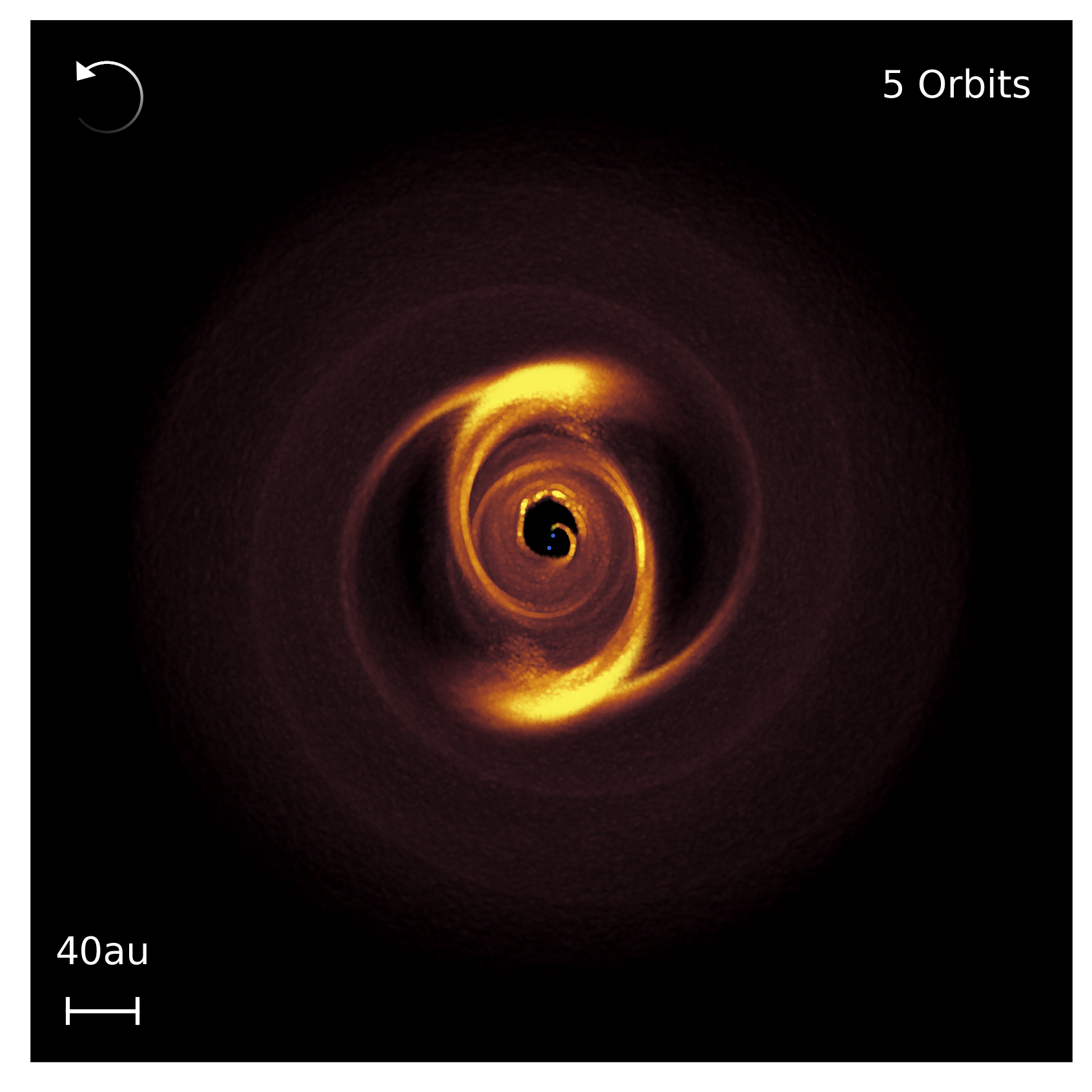Leading & Trailing Spiral Arms in a Nearly Broken Protoplanetary Disc
Disc Evolution
Figure 1 shows the evolution of a 0.2 Solar mass circumbinary disc that is misaligned relative to the binary. The misaligned binary causes the disc to become warped resulting in the formation of leading spiral arms.
- In the early phase of the disc's evolution, the relative disc misalignment of the inner and outer disc is at its highest. The spirals are also at their weakest during this time, and almost disappear as the disc breaks.
- The relative disc misalignment of the inner and outer disc reduces as the disc realigns. During this intermediate phase, leading spiral structures are at their strongest.
- The leading spiral arms vanish in the final phase when the disc has realigned, and is no longer warped.
These spirals differ from more typical mechanisms for forming spirals such as gravitational instability or planets in two important ways. Firstly, the spirals are pointing in the opposite direction, they are leading instead of trailing. Secondly, they do not rotate with the disc.
Why Are There Leading Spirals?
When the disc is misaligned, the torques are non-zero due to neighbouring annuli of gas having misaligned angular momentum vectors (Lodato & Pringle 2007). The torques result in angular momentum transfer across radii, exciting radial velocities that transport mass radially to redistribute angular momentum.
- At 2 orbits, the relative disc misalignment is large enough to nearly break the disc into two unconnected misaligned discs. Although the misalignment still generates torques, the weak connection between the inner and outer disc results in inefficient angular momentum transfer. Thus, the spirals are also weak in this phase.
- At 5 orbits, the disc is warped. The relative misalignment is moderate allowing for the inner and outer disc to remain connected. Angular momentum is efficiently transferred through these two narrow nodes. It is precisely in these regions where the leading and trailing spiral arms originate in the outer and inner disc, respectively. Outward and inward radial velocities are excited at these nodes resulting in the spiral structures seen in the density plots.
- At 10 orbits, the inner and outer disc have realigned. Hence, the spirals disappear since the torques that drive angular momentum transfer are reduced. Additionally, any angular momentum transfer can now occur at all azimuths since the inner and outer disc are no longer connected at two narrow nodes.
A crucial difference from other mechanisms that launch spirals is that the two connecting nodes do not corotate with the disc. The increased radial velocities due to angular momentum transfer from a non-corotating perturbation naturally results in leading spiral arms.

The Impact of Shadows
Figure 3 shows the evolution of the relative misalignment of the inner and outer disc in a 0.02 Solar mass circumbinary disc. In the top right, the deviations from symmetry is also plotted to improve the visibility of spirals.
- In simulations using live radiative transfer to determine the disc temperatures, there is a second mechanism that can also launch spirals. The shadows cast by the misaligned inner disc onto the outer disc forms trailing spirals.
- The trailing spirals due to shadows are only visible at large relative misalignments when the disc is broken. The shadows do not corotate with the disc. Therefore, the trailing spirals do not either.
- At lower relative misalignments, the inner and outer disc are connected at two narrow nodes. In this regime, the leading spirals arms are dominant.